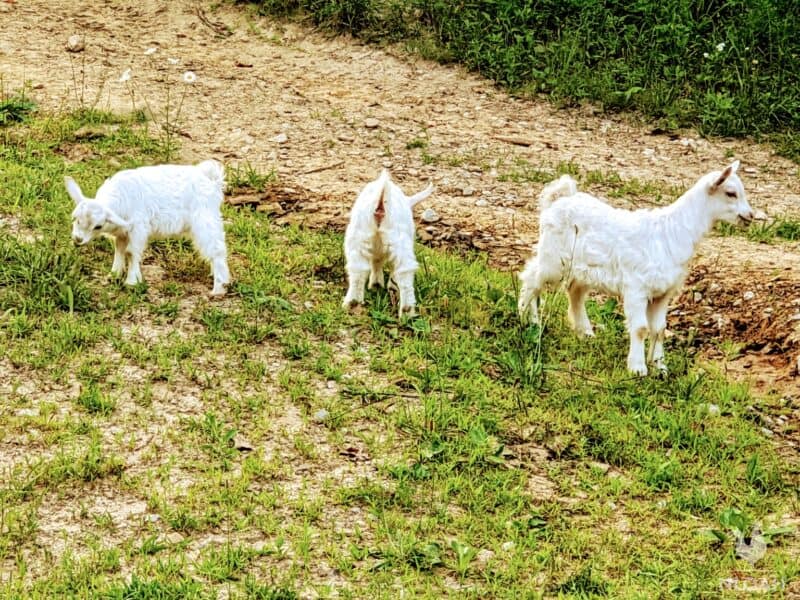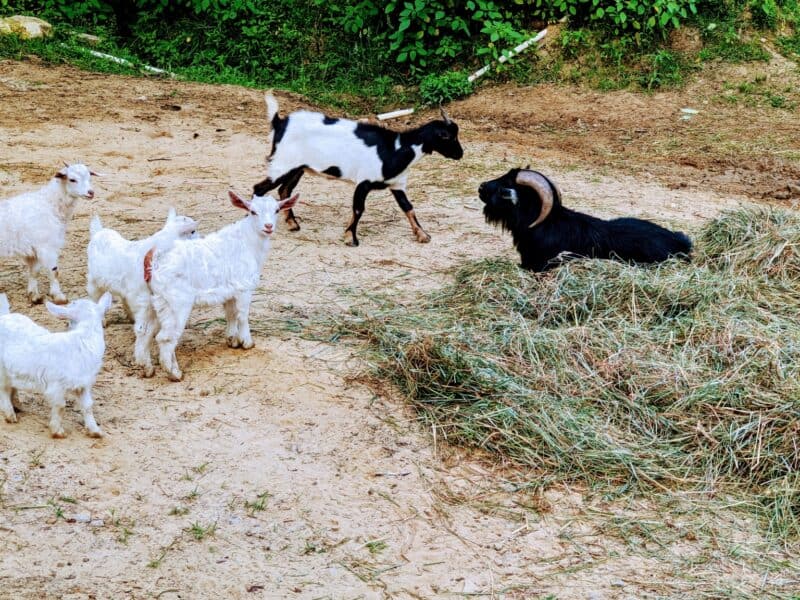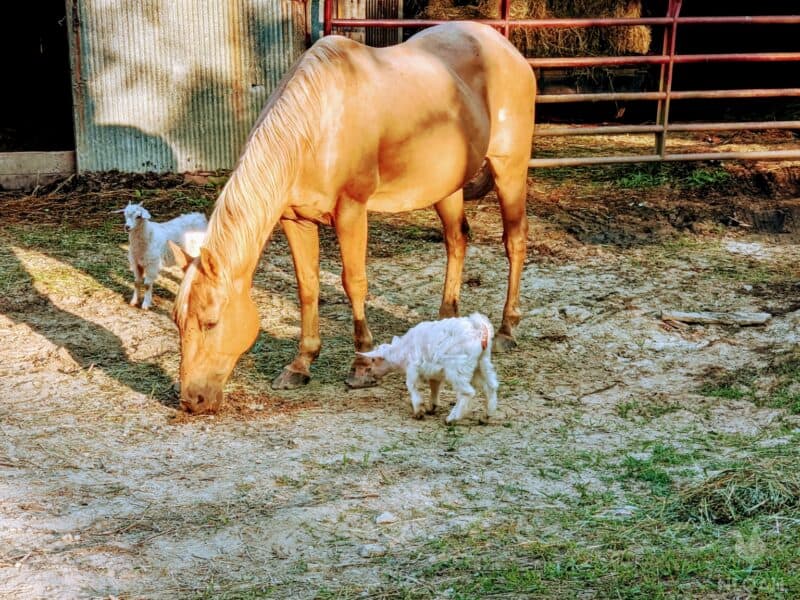Pygora goats are a relatively new addition to the fiber goat industry. They were developed in the United States during the 1980s – and became hugely popular with keepers both large and small.
These miniature goats are one of the smallest of all 300 or so goat breeds on the planet and are the smallest fiber goat in existence. Although keeping sheep for wool fiber is still more commonplace in the United States, developing goat herds for their mohair fiber is on the upswing.

Table of Contents:
Pygora Goat Breed Facts
- Pygora goats were developed by crossing Angora goats and Pygmy goats. Angora and Cashmere breeds are the only other types of fiber goats on the planet.
- Angora mohair comes from goats, but angora wool comes from rabbits. The two fibers are often confused by consumers.
- Mohair was the label placed upon the fleece sheared from Angora goats. It stems from the Arabic term “Mukhaya” which means “cloth of bright lustrous goat hair.”
- A Pygora is similar in size to both the miniature meat Pygmy goat breed, and to the small stature dairy Nigerian Dwarf goat breed. They are slightly smaller than Kinder goats.
- The manual or electric shears used to remove wool from sheep are used to painlessly shear mohair from goats.
- Pygora goats can produce three different types of mohair roving – or fleece. They produce a cashmere (Type C) style fleece, a mohair (Type A) style fleece, and a combination (Type B) of the two.
- These miniature fiber goats traditionally come with coats in shades of white, black, gray, brown, and a mixture of those colors.
- Pygora mohair can easily be dyed naturally or with commercially manufactured colorants.
- A mature female Pygora goat stands approximately 18 inches tall.
- A mature Billy (or buck) Pygora goat stands roughly 23 inches tall.
- A Pygora Billy that has reached maturity typically weighs between 75 and 94 pounds.
- A Pygora nanny or doe that has reached maturity weighs 63 to 75 pounds, on average.
- The average lifespan of a Pygora goat is 12 to 15 years old.
- The long and incredibly smooth Pygora goat mohair fibers are often used in the making of sweaters, toboggans, scarves, and lace for intimate apparel.
- Most Pygora goats are allowed to live to a ripe old age because their mohair remains soft and of excellent quality even when they hit their senior years.
- Even though Pygora goats are kept primarily as fiber goats and farm pets, they can be considered an above-average dairy goat as well. A Pygora nanny goat is capable of producing a little more than 1 quart of sweet butterfat rich milk on a daily basis.
- Pygora goats are also casually referred to as “miniature Angora” goats.
- The Pygora Breeders Association was created in 1987 and has remained focused on the breeding and promotion of this miniature goat breed ever since.
- The Nigora goat breed is a relatively similar miniature fiber breed that was also created in the United States to foster small-stature mohair goats.
- Pygora goats can be taken as project animals to the county fair by even young 4-H Club members in both the fiber and breeding goats categories.
What Is Goat Fleece?
Goat mohair is soft and fluffy, making it perfect for use in creating lace, knitting, wet and needle felting, wig making, spinning, and weaving.
Mohair from miniature fiber goats and their Cashmere and Angora standard stature peers is more durable, crease resistant, flame retardant, and (naturally) more elastic than wool. Like silk, goat mohair is considered a “luxury” fiber.
Contrary to some extreme articles I have read and graphic videos published by animal rights groups, in the United States, at least, goats are not butchered for their coats.
Instead, goats are shorn twice a year just like sheep, then go on about their merry way to grow another light and fluffy coat.
Pygora Goat History
This miniature fiber goat breed was created in Oregon City, Oregon by Katharine Jorgensen during the 1980s. Jorgensen was already a keeper of Pygmy goats and spent some of her time working with community youth as a 4-H goat judge.
During a trip to a Southwest reservation for Native Americans, Katharine Jorgensen was pleasantly taken aback by the amazingly colorful and soft mohair goats kept on the grounds.
Having a love of fiber arts, the Oregon goat farmer decided to turn her attention to developing a miniature fiber goat breed using the Pygmy herd she was already keeping at its base, and Angora goats.
This miniature fiber goat breed was started by crossing a NPGA registered Pygmy goat with a AAGBA registered Angora goat.

Pygora Goat Characteristics
- Pygora goats are known to be as curious and social as the Pygmy goats that helped foster the breed. The miniature fiber goats are also as easy to handle as their Angora ancestors. Pygora goats are typically intelligent and playful who quickly learn the shearing routine – just as a dairy goat would learn to grasp the milking process.
- A Pygora goat generally gives birth to just one kid her first time, but in subsequent pregnancies, it is not uncommon for a Pygora goat to throw four kids – typically one or two sets of twins.
- The gestation period for Pygora goats is roughly 145 to 152 days.
- Newborn Pygora goat kids weigh between two to three pounds each.
- It takes only moments for these miniature fiber goat kids (like other goat newborns) to stand, nurse, and begin both romping and seeking affection.
- The kids are commonly weaned by the time they are 12 to 14 weeks old.
- A Pygora kid is deemed mature when it is only eight to 12 months old. Pygmy and small-stature goat breeds are not typically considered mature until they are 24 months old.
Pygora Goat Shearing Tips
- Always give the Pygora goat a bath, and then blow away as much dirt and debris from their coat as possible. Use the blow dry on a cool heat setting or air compressor nozzle to blow the debris ALONG the side of the soft fleece coat and not directly down onto it to avoid the dirt and debris from going deeper inside or become even more tangled.
- Once the miniature fiber goat has been cleaned, start shearing a single strip line along the goat’s backbone from the tail up towards the withers.
- Continue shearing the goat on either side of the backbone down toward the sides of the sheep – keeping the shearing blades parallel to the animal’s side will help prevent nicking his or her flesh.
- If you are shearing during cold weather months, always leave a light layer of wool on the goat to prevent the animal from getting chilled and perhaps developing an illness – especially the dreaded goat pneumonia.
- When shearing along the underside of the miniature fiber goat’s belly, be especially careful and shear slowly around the teats, penis, testicles, or udders.
- Also use caution when shearing on and around the hind legs. Make sure you are keenly aware of back leg tendon placement when shearing to avoid nicking the area with the trimming tool.
- When shearing along the front shoulder conformation, do not shear across but up and down to avoid cutting the flesh that runs in between the bones.
- The chest and neck area of the goat are shorn last. Do not cut any wattles the goat may have and shear slowly, gently, and carefully around the throat area.
- Look the goat over entirely for any cuts or nicks and treat them with a triple antibiotic ointment – or your typical livestock first aid cream, to prevent dirt and debris from getting into them and causing an infection.
- Once the Pygora has been shorn, make sure he or she has plenty of safe clean bedding and a place that is neither too moist or humid, to sleep.
- You can also wrap a “goat coat” around the recently sheared Pygora, and allow the animal to wear it for a few days as its fleece begins to fill back in.
These miniature fiber goats are not only easy keepers but they tend to be easy at the kidding process, as well. Many goat breeds have difficulty during kidding and need human intervention to make it through the process.
Pygmy goats, in my personal experience, tend to be easy kidders also, and perhaps this trait has been passed onto the Pygora goat breed.

These little fiber goats do not require any special husbandry techniques, feed, fencing, pen, or medical care. They are good browsers and free rangers – perhaps a trait that was passed on from their Angora ancestry.
The largest herds of Pygora goats are most often found in Oregon and Texas. Buying a member of this miniature goat breed will likely require traveling to a breeder or having the Pygora shipped to your homestead.
Homestead Fiber Business
Angora and Cashmere goats offer more fiber per animal. They are not only costlier to purchase and keep, but are only suitable for large homesteads.
The Pygora goat offers backyard and small acres homesteaders the opportunity to raise their own fiber, and perhaps make some extra money selling it as a homestead-based business.
When a homestead goes from being a lifestyle choice or “hobby” and into a money making endeavor, you can claim related business expected on your income taxes.
Common related farm expenses include animal purchase price, grain feed, electricity and water used in husbandry practices, hay, straw, fencing, feeders, waterers, veterinary care, and typical office expenses.
A mature goat is capable of producing between 8 to 16 pounds of mohair annually. A goat kid can be shorn once its hair is at least four inches long.
This fine hair often brings a higher price. A goat kit can produce between three to five pounds of mohair in a year. A single pound of mohair can sell for up to $10 per pound.
How Much Does a Pygora Goat Cost?
If having a registered member of the breed is not an important factor to you, purchasing an Angora goat and breeding it with a Pygmy goat – which is far easier to find throughout the United States, will likely be a far less expensive way to start a miniature fiber goat herd.
Depending on their size, age, sex, training level, and other criteria, the prices for Pygora goats can range anywhere from as little as $200 to over $1000. If you’re looking to buy one of these amazing creatures, you may want to consider local sources like farms or animal shelters that may have an adult goat available at a lower price point.
If you’re looking for quality animals that meet the Pygora breed standard, be sure to consult the Pygora Breeders Association.
This organization maintains the registry herd book and will help you identify animals that were bred from the two required parent breeds (this information comes from the National Pygmy Goat Association and the American Angora Goat Breeders Association, respectively).
Can You Milk Pygora Goats?
But not many people know that it’s possible to milk pygora goats! Pygora goats are actually excellent, low-maintenance dairy goats and can produce up to 1.5 times more milk than standard dairy goats.
That said, there are some challenges.
Unlike other dairy breeds of goat, pygoras have been specifically bred to produce much higher levels of luxurious soft fibers. Therefore, you need to be careful during the milking process, as you don’t want to damage the valuable knitting or weaving fibers.
The flavor? A special creamy and slightly sweet unique taste that perfectly complements any recipe.
What Do You Feed Pygora Goats?
To best meet the needs of your Pygora goat, it is important to provide them with a balanced diet that contains quality hay or grasses, fortified goat feed, and minerals.
While hay should form the foundation of the diet for your Pygoras, supplemental grain such as oats can be fed daily in limited amounts.
To keep their coats glossy and healthy, aiming to ensure they receive at least two percent of their body weight in fiber each day is critical. You should also provide supplements like kelp and salt-free minerals to maintain optimal health.
Do You Have to Shear Pygora Goats?
Although these animals may not need shearing for survival like other breeds of goat, it is highly recommended. That’s true even if you don’t plan on selling the fleece. Here’s why…
Without regular clipping of the goat’s hair, they can become matted, which can lead to discomfort and health concerns. Aside from that, shearing once or twice a year allows shepherds to put the soft and gorgeous Pygoras fleece to use.
Shearing is essential not just for monetary reasons – it’s important for the health of your herd. It offers a drastically reduced risk of flystrike and other issues that can prevent your goats from remaining in good health.
For healthy goats, even if you don’t plan on selling the raw fiber, shearing is vital.
Ultimately, raising Pygora goats is a great choice for any homesteader interested in fiber production. With these tips, you now know everything you need to know about the proper care of these beautiful animals!
Pygora Goats FAQ
The amount of fiber that a single goat can produce depends on several factors such as genetics, diet, and environment. Generally speaking, you can expect a healthy adult Pygora goat to produce between two and five pounds of fiber in a year.
Pygoras are small goats, typically reaching heights up to about 18 inches at the shoulder when fully grown. They usually weigh between 50-80 lbs when fully mature.
Pygoras are known for being gentle and friendly animals who bond easily with humans and other animals. Their sweet dispositions make them great companions for those who are looking for an affectionate pet.
While all goats have their own individual personalities, this breed is known for being particularly docile and easy to handle—making these ideal pets for those who want an animal companion but don’t have the time or resources necessary to take care of more high-maintenance breeds like dairy goats or larger animals.


Tara lives on a 56 acres farm in the Appalachian Mountains, where she faces homesteading and farming challenges every single day, raising chickens, goats, horses, and tons of vegetables. She’s an expert in all sorts of homesteading skills such as hide tanning, doll making, tree tapping, and many more.
